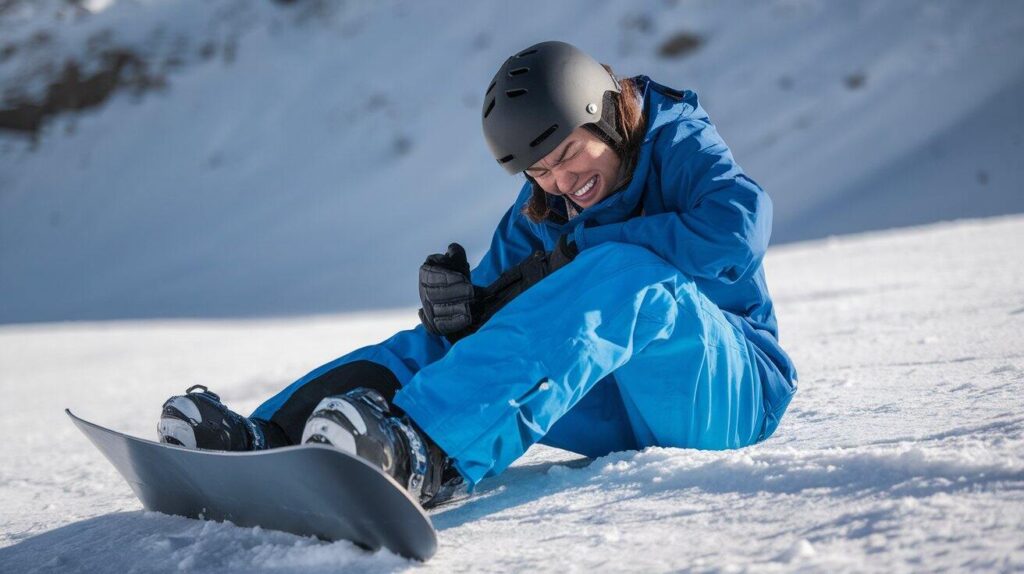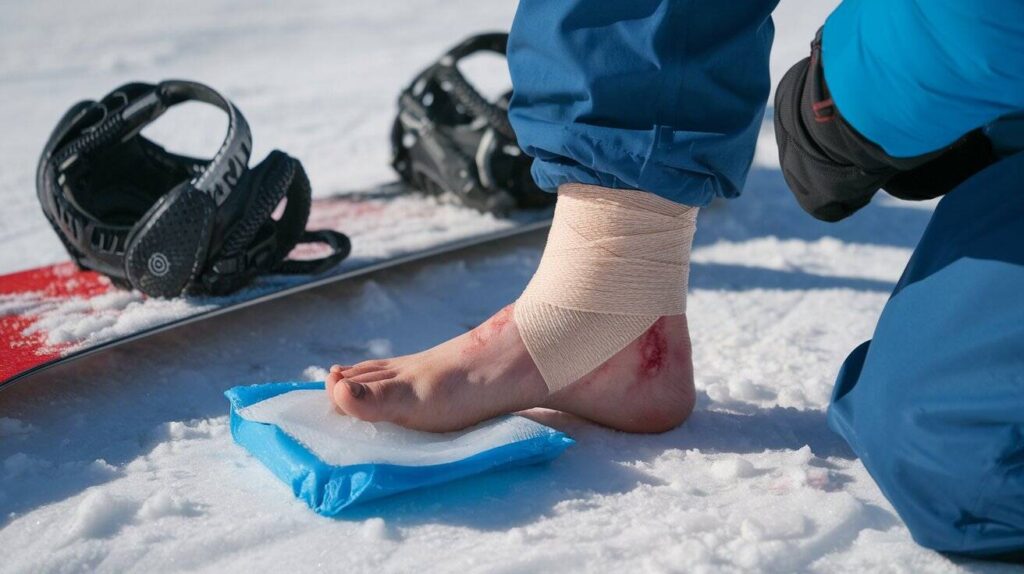It was good snowboarding but if you fall badly you’re going to hurt and unfortunately, you will be out longer than you care to be. Falls can really take you out of the sport you love, forcing you to slow down. The good news? In the event you twist your knee or fall down the line while snowboarding, you will know the specific measures that have to be taken to rapidly recuperate and get back up one more lift ridge.
It also has simple advice for what actions should be taken after a fall as well as other stretches and mobility exercises for a speedy recovery. But, in addition to top recovery tools and tips to prevent injury, you’ll learn about the importance of nutrition and hydration in aiding recovery. Learn how to fail hard but not fall hard, recovering quickly from a snowboarding fall.
Why It’s Important to Know How to Recover Quickly from a Snowboarding Fall
This knowledge is useful since it enables one to get back on the snowboard more easily and helps minimize the potential for serious tissue damage. Snowboarding is a kind of risky sport and it is a very impact sport in which people fall frequently even if they are experts. If you do not know how to get well, a simple stumble could result in even worse, longer suffering, as well as danger.
New snowboard fall techniques show you how to best prevent or begin the healing process to minimize swelling, soreness, and stiffness. This way it will also reduce the chance of its worsening or other existing injuries taking longer to heal. In addition, if you can gain fitness faster, you get to play your preferred sport for longer rather than be on the bench.
Immediate Steps to Take After a Snowboarding Fall
That’s why knowing what to do the moment you get off your snowboard can have a great impact on your recovery. Understanding how to reduce damages in the event of a snowboarding fall also begins with speed.
First of all, do not panic, and check if you are hurt. If you are in pain stay down don’t try to get up, try to wiggle a little first to see if you can make the pain any worse. If everything is fine then slowly rise to prevent fainting or to make some more discomfort.
After that, use ice on parts of the body that feel stiff or irritated. Ice also relieves swelling and pain, which is important in the initial days of recuperation. If possible, try to raise the injured area above the heart, so as to minimize both blood flow and inflammation to the area.
Finally, take a break.

If you had any injury going over all do not attempt to continue riding. One of the many means of ensuring that your body heals fast when it has fallen is by resting on it immediately.
How to Recover Quickly from a Snowboarding Fall Using Stretching and Mobility Exercises
So I can honestly tell you from first hand experience with snowboarding, if you do go down in a fall, stretching and mobility exercises can help heal and get you back on that board, much quicker. So you will take care of your body learning how to recover quickly from a snowboarding fall by doing gentle movements.
Do some light stretches to warm up your muscles the first thing you should do. You can pay attention to places that are going to seem tight, your legs, your back, your hips. This means simple hamstring stretches or gentle back twists to build flexibility and decrease stiffness.

As you hold each stretch for about 15-30 seconds take a deep breath and relax your muscles.
You then move into mobility exercises, which are movements through your entire Joint range of motion. For the injured areas, some simple movements like ankle circles, knee bends and shoulder rolls will also keep joints loose, and can also help get you calmer than elite athletes can.
Performing these stretching and mobility exercises as often as is recommended is beneficial to your body in terms of treatment as well as injury prevention in the future. Knowing the basics of how one can get over rapidly in case of a snowboarding fall is going to have you up on the snow in no time.
Top Recovery Tools to Help You Recover Quickly from a Snowboarding Fall
Having the appropriate recovery tools is often beneficial when you wish to recover quickly after a snowboarding fall. Here are some top tools that can help you heal and get back on the slopes faster:
Ice Packs: Assembling ice packs over any delicate area of the body after a fall is likely to reduce swelling and pain. Ice packs should be applied only during the initial 24 to 48 hours following any kind of injury.

Foam Rollers: Selfmassage with the help of foam rollers is such a wonderful thing that can truly assist in releasing the muscle tissue and activating the blood flow! Light rolling over the affected areas without applying much pressure can reduce the tension, speed up the healing process, and, indeed, would be enjoyable.
Resistance Bands: Great for gentle stretching and strengthening exercises, these bands are perfect. They can help you to be flexible and rebuild muscle strength after a fall.
Compression Gear: Compression sleeves or socks can help the swelling and also support damaged muscles while they heal. And that can help improve circulation, a good thing for recovery.
Massage Balls: They’re also great for targeting hard to reach, tight spots in your muscles. But use them anyway to massage sore areas help release tension and improve mobility.
With these recovery tools, you can do a lot to boost your healing process. Learning how to get back on the snowboard quickly, and using these tools in your regular routine means you’re back on the snowboard and doing what you love in no time!
How to Prevent Future Injuries After Learning How to Recover Quickly from a Snowboarding Fall
Once you understand how to bounce back after a snowboarding fall, it is wise to ensure you don’t get another injury. Here are a few straightforward steps you can follow to ensure your safety on the slopes:
Build Muscle Strength: Besides, stronger legs, core, and back muscles will help strengthen a person before snowboarding. And if you can practice squats, lunges, and planks to strengthen your overall strength and balance, really consider doing that.
Stay Flexible: The stretching keeps your muscles flexible and helps to prevent strains. Stretch in your day after snowboarding if not other days.
Warm Up Before Riding: Before hitting the slopes always check in with your muscles and take a few minutes to warm them up. It can be light jogging, a dynamic stretch or even simply moving around to get the blood flowing and get your body ready for snowboarding.
Use Proper Gear: However, wearing the right equipment, i.e., helmet and boots properly, can protect you against injuries.

When it comes to gear, be sure your gear is in your level of knowledge and also snow conditions.
Know Your Limits: Know where you stand with your skill level and don’t overdo it. Pick runs that match your condition and give yourself a break occasionally to not get tired.
By heeding these tips, you can cut your chance of injury and have a safe time snowboarding. Similar to knowing that coming up after a fall is as crucial as learning how to evade other snowboarding dangers, knowing how to snowboard is equally crucial.
How Nutrition and Hydration Can Help You Recover Quickly from a Snowboarding Fall
It is clearly evident that good nutrition and adequate fluid intake if consumed when you are in a snowboarding fall will enhance your fast recovery. The kinds of foods and drinks you take certainly influence how well your body is able to heal itself. Here’s how you can enhance your recovery with proper nutrition and hydration:
Stay Hydrated: It is especially important after a fall to drink enough water. Hydrating helps your body recover from your workouts, decreases pain, and generally ensures that your body works in tip top shape. Drink lots of water, especially in between and following snowboarding.

Consume Protein-Rich Foods: Muscles and tissues need proteins to be rebuilt so to improve muscles and tissues repair, they need proteins. You should also take lean meats, fish, eggs, beans, and nuts on your diet. What the research has also shown is that when protein is ingested after working out it assists in the repair work that occurs most in muscles during this period.
Incorporate Fruits and Vegetables: Any dieting program should be taken with vitamins and minerals and fruits and vegetables are the most recommended sources of nutrients. Other fruits include blueberries and oranges and green vegetables include spinach and broccoli are other Examples of foods containing some anti-inflammatory antioxidants that counterbalance the effect within the body and then bodies start its healing. However, one should not consume a lot of red and processed meats because they cause inflammation hence developing various diseases.

Add Healthy Fats: Avocado, olive oil, and nuts contain also monounsaturated fats, which are good for health and have the capability to decrease inflammation levels. Consuming these food types can help in your recovery process The recommendation is as follows:
Choose Smart Snacks: During the day, ensure you take healthy snacks like yogurt, smoothies, or trail mix to keep you energized as your body heals.
There are many ways through which improving your nutritional value and water intake after a fall positively affects your body. Every snowboarder has already thought about how they plan to recover quickly from a snowboarding fall. Not only physical care but also the right foods and drinks fuel in body. It’ll also help you get back up on the slopes quicker if not feel better overall!
When to Seek Medical Attention While Trying to Recover Quickly from a Snowboarding Fall
It’s important to know when to see the doctor after a snowboarding fall, for your health, prevention, and recovery. Many falls lead to nothing more than a few aches and pains, but some injuries can be worse. Here are some signs that indicate you should see a doctor:
Severe Pain: If you experience pain so severe it doesn’t respond to ice, rest and even over the counter pain relief, it could indicate a more serious injury that requires medical evaluation.

Swelling or Bruising: If there is a lot of swelling or bruising around an injury it could mean something is wrong. If the swelling is very severe or doesn’t get better after some days you should visit a doctor.

Inability to Move: If you are unable to or can not at all bend a joint or limb it is advisable that you consult a doctor. If it is the crack alone which is offending you then that may well be a sprain, a fracture, or some other different type of injury that always demands professional help.
Numbness or Tingling: Loss of feeling, shouldering, or even weakness in your arms or legs after a fall may also be due to a nerve injury. All these mentioned are symptoms that are a sign that one should seek treatment for one’s condition.
Head Injuries: Assuming that you have a headache after having a minor knock on the head and you develop complications such as dizziness, confusion, nausea or fainting, you should consult a doctor for concussion.

Understanding that there is always a time when you will need assistance after a snowboarding fall is also a part of the recovery process. If you have these symptoms or are in doubt whether or not you have your condition it is always advised to seek the professional services of a physician. First, let me start with something quite obvious – being physically fit is a great way to start repairing the damage of the summer!
Conclusion
Now that you know how to recover quickly following a snowboarding fall, every snowboarder, well, you should. Knowing how important recovery is after a fall, and taking action immediately following a fall reduce suffering and get you back to the slopes quicker. Stretching and mobility exercises, helpful recovery tools, nutrition, and hydration will help you heal. And in any case, as long as you are aware of when to see a doctor the better you will take care of yourself. These easy and quick tips will make you ready to safely and easily enjoy the snowboarding!
FAQs
How to recover from snowboard falls?
If you take a snowboard fall, the first step is to check out how injured you are and if you can apply ice to any sore areas to lessen swelling. Rest is needed so give your body time to heal and add gentle stretching and mobility exercises to get you back to freedom. So, you’ll also need to stay hydrated and eat nutritious foods, getting you back on the slopes safely and quickly!
How to get up after falling snowboarding?
First, when you fall going snowboarding, turn yourself onto your side and push yourself onto your hands and knees and get up. Second, you put one foot in front of you and stand up with your weight centered over your board. It doesn’t matter what option you took: always check your surroundings and take a minute to make sure you are ready to descend one more time!
How can I speed up my fall recovery?
To recover faster from your fall, you may want to focus on resting and listening to your body. Ice it if you need to reduce swelling, keep hydrated, and eat healthy food with plenty of protein and vitamins. Gentle stretches and mobility exercises are also terrific at improving flexibility and strength and getting you back on your feet as quickly as possible!
How do you recover from ski fall?
If you fall skiing, first rest and see if you are injured. If sore, ice to reduce swelling and, if needed, take over the counter pain relief. It can be gentle stretching and light movements during the recovery, drinking tons of body fluid, and eating nutritious nutrition to help you with the recovery!
If you take a snowboard fall, the first step is to check out how injured you are and if you can apply ice to any sore areas to lessen swelling. Rest is needed so give your body time to heal and add gentle stretching and mobility exercises to get you back to freedom. So, you’ll also need to stay hydrated and eat nutritious foods, getting you back on the slopes safely and quickly!
First, when you fall going snowboarding, turn yourself onto your side and push yourself onto your hands and knees and get up. Second, you put one foot in front of you and stand up with your weight centered over your board. It doesn’t matter what option you took: always check your surroundings and take a minute to make sure you are ready to descend one more time!
To recover faster from your fall, you may want to focus on resting and listening to your body. Ice it if you need to reduce swelling, keep hydrated, and eat healthy food with plenty of protein and vitamins. Gentle stretches and mobility exercises are also terrific at improving flexibility and strength and getting you back on your feet as quickly as possible!
If you fall skiing, first rest and see if you are injured. If sore, ice to reduce swelling and, if needed, take over the counter pain relief. It can be gentle stretching and light movements during the recovery, drinking tons of body fluid, and eating nutritious nutrition to help you with the recovery!

